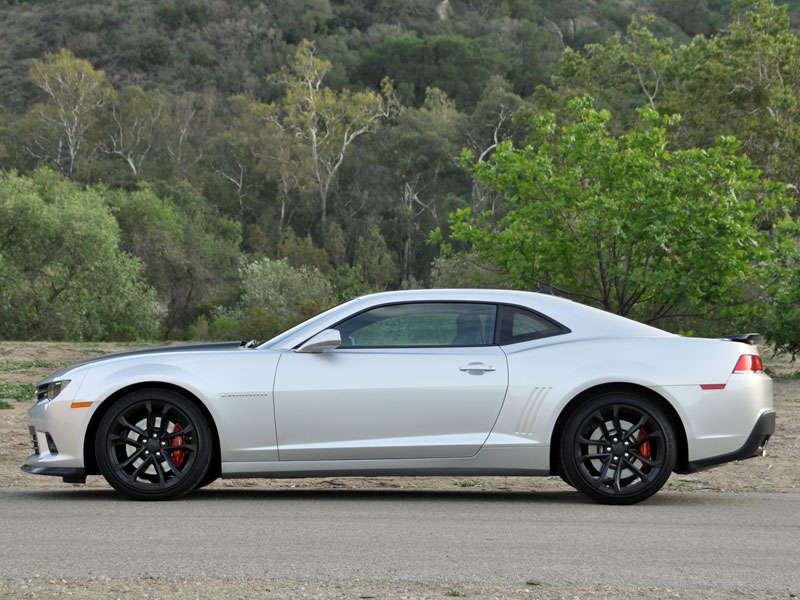Recent Articles
Popular Makes
Body Types
2014 Chevrolet Camaro SS Review and Road Test
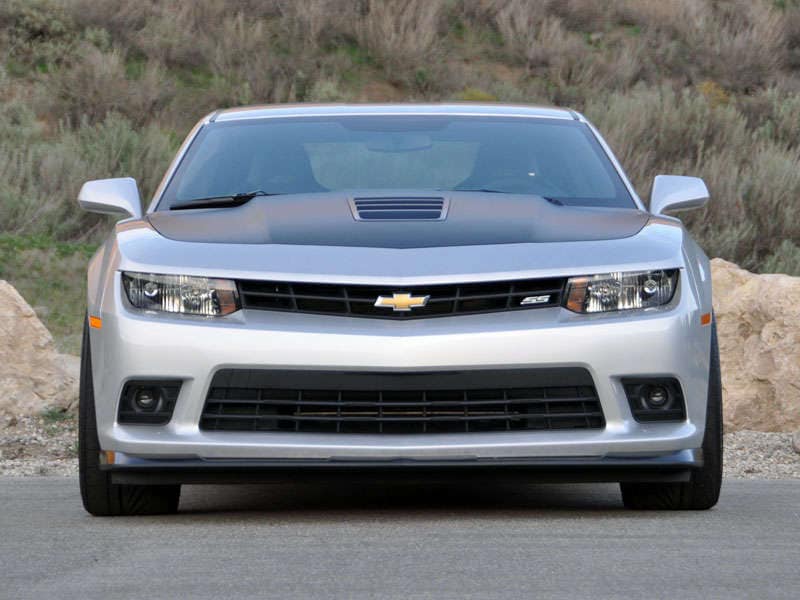
Drive a 2014 Chevy Camaro, especially one with a matte-black ventilated hood and a set of massive black wheels fronting red-painted brake calipers, and you generate lots of attention, much of it negative. We’re talking about the Camaro SS equipped with the 1LE Package, and in addition to installing performance-enhancing hardware for this model Chevrolet might as well paint “I GO FAST” in giant letters along the sides, inspiring the police to give this car, and its driver, extra attention.
In addition to heightening the sensitivity of law enforcers equipped with radar guns, this rumbling Camaro SS appears to threaten the general populace just by showing up somewhere. Make any particular move construed as remotely aggressive by other drivers or pedestrians, and you can probably guess how they’re characterizing you. But after spending a beautiful afternoon driving this particular example of the breed on the coastal and mountain roads around Malibu, Calif., I simply don’t care.
This is a special car.
2014 Chevrolet Camaro SS Review and Road Test: Models and Prices
There’s no shortage of variety in the 2014 Chevrolet Camaro lineup. First, you must choose between a coupe and a convertible. Stick with the fixed-roof version, and you can get the Camaro in LS, LT, SS, ZL1, and Z/28 model series. The Camaro Convertible is available in LT, SS, and ZL1 series designations.
The base price for the Camaro LS Coupe is $24,550, including a destination charge of $995. The Camaro LT commands $26,850, and if you get the convertible model the price tag rises to $32,050, making it a very expensive tanning booth and Brazilian blow out treatment. All Camaro LS and LT models are equipped with a V-6 engine.
If you want a Camaro with a V-8 engine, the SS Coupe wears a price tag of $34,350. Chop off the top, and the sticker inflates to $40,350. Then there are the ZL1 variants to consider, at $57,650 and $62,850, respectively. Finally, sitting at the top of Camaro Mountain, the new-for-2014 Camaro Z/28 Coupe costs a cool 75 grand.
There’s a reason that the Camaro Z/28 is so expensive. I’m guilty of only a little bit of hyperbole when I tell you that it’s basically a racing car set up for street driving. Everything about the Z/28 is optimized to deliver the fastest possible lap times, so while its 505-horsepower, 7.0-liter V-8 engine might not be as powerful as the Camaro ZL1’s mighty 580-horsepower, supercharged 6.2-liter V-8 engine, the intent with the Z/28 is to maximize speed around a track, not in a straight line.
My test car started down the assembly line as a Camaro SS Coupe dipped in Silver Ice Metallic paint. To this, Chevrolet installed a navigation system ($795), Recaro performance seats ($1,995), and the 1LE Package ($3,500), for a total of $40,640.
What makes this Camaro SS a special car is that optional 1LE Package. It includes 20-inch wheels painted low-gloss black and wrapped in Goodyear Eagle F1 Supercar summer performance tires, a reworked suspension with larger front and rear stabilizer bars, and a strut-tower brace along with a matte-black front splitter, a matte-black hood treatment, a matte-black rear spoiler, and red-painted brake calipers. An exclusive, track-ready, close-ratio, 6-speed manual gearbox with a 3.91 final-drive ratio and an air-to-liquid cooling system is also included with the 1LE Package, along with a list of ZL1-derived bits and pieces including a flat-bottom steering wheel and short-throw shifter wrapped in suede microfiber material.
The end result is a very entertaining automobile.

2014 Chevrolet Camaro SS Review and Road Test: Design
- New front styling (except ZL1)
- New rear styling with LED taillights
- Standard aluminum wheels
- SS models get ventilated hood
- Red Hot, Bright Yellow, Red Rock Metallic paint colors
- Optional Blue interior accent package
- New track-ready Camaro Z/28 Coupe
Restyling a retro-themed car is dicey business, but success in such an endeavor is not impossible. Modeled primarily after the iconic 1969 Camaro, today’s version of Chevy’s rear-drive coupe features a blend of classic and contemporary design cues that are updated for the 2014 model year.
New front styling is added for all 2014 Camaro models, except for the ZL1 version. The ZL1 needed to retain its previous look because it is specifically designed to maximize engine cooling for that particular model. Chevy also installs a new ventilated hood for Camaro SS models, and around back new wrap-around LED taillights debut, reminiscent of the 1974-1992 Camaro models.
The result is a modern muscle car that looks lower and wider than the previous Camaro. Personally, I think Chevy made a mistake by dropping the black-painted steel wheels that used to be standard on the basic LS models in favor of standard aluminum wheels, but otherwise the styling updates are appealing.
While I’m complaining, I might as well mention one other thing that irritates me, and lots of other drivers, about the Camaro and other GM products. When you leave the car at night, the reversing lights illuminate for a short period of time, apparently in order to provide extra illumination at the rear of the vehicle. However, in a crowded parking lot, other motorists believe you are about to exit a coveted space. They’ll stop, turn on their signal, and then wait. They might even pass up another opportunity to get a different parking space. Then, suddenly, the lights go off, and the driver who thinks he or she has finally scored a parking spot is left confused and aggravated. Having been the driver on the receiving end of this on more than one occasion, I can tell you that GM needs to change its approach.
Inside, things are the same as last year. My test car came equipped with the new Recaro seat option, but otherwise there are no changes of note, which can be taken as either a good thing or a bad thing, depending on your perspective. From mine, I still miss the ultra-cool retro-style steering wheel from the 2010 Camaro, and I think that Chevrolet needs to upgrade the plastic covering the center console, which looks and feels really cheap, and is a significant source of discomfort when the Camaro is driven as intended.
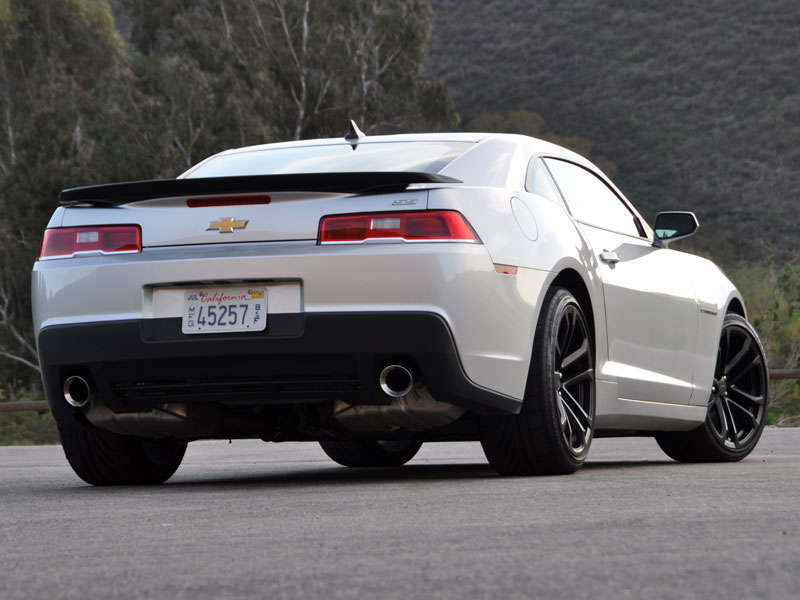
2014 Chevrolet Camaro SS Review and Road Test: Comfort and Cargo
- Optional Recaro performance seats for SS Coupe
You are likely to smack yourself in the head and say, “Well, duh!” when I tell you that it is not easy to get into or out of a Chevy Camaro. Especially one equipped with the deeply bolstered Recaro seats. The doors are long, the roof is low, and the sills are high. Depending on the parking situation, you’ll resemble a contortionist as you enter or exit the car.
Once you’ve parked your butt in one of the front seats, though, you’ll be comfortable, especially in the Recaros, which strike me as well worth the $1,995 cost. My test car’s 1LE Package provided a steering wheel and a shift knob sourced from the Camaro ZL1, each wrapped in suede microfiber. Chevy needs to add an extra layer of padding under this rather thin material, especially for the steering wheel, because it’s uncomfortable to grip after a couple of hours on the road.
Toss the Camaro into a set of curves, and you’ll also find hard plastic covering the parts of the cabin where the driver is likely to brace legs and knees against the resulting g-forces. Given the amount of time that engineers have spent thrashing Camaros on racetracks all around the world, I can’t believe any of them failed to mention that spending a little extra to pad the center console and door panels might be a good idea.
While the Camaro is designed to seat four people, I don’t recommend asking people whose company you genuinely value to ride in the back seat. The seat itself is quite comfortable, but headroom and legroom are in very short supply. Children and smaller adults are acceptable, but nobody else.
The Camaro’s trunk measures 11.3 cubic-feet, more than might be expected. The shape, however, limits what can be placed inside. The liftover height is high, the opening is small, and the trunk floor is shallow. Nevertheless, by exercising care, two full-size suitcases fit, leaving extra space for smaller items.
As might be deduced by looking at a Camaro, outward visibility isn’t good, which makes Chevy’s decision to put a reversing camera on the options list rather than on the standard equipment list a bad one. Without these features, backing up is an exercise in blind faith. The thick windshield pillars are also a liability on seriously sinuous roads, blocking the view of oncoming cyclists, motorcyclists, and small cars when bending around sharp, blind corners.
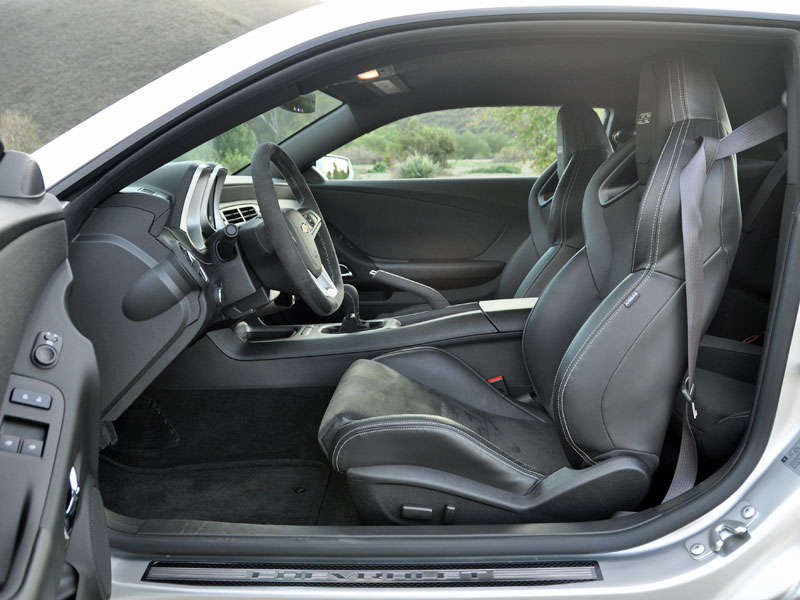
2014 Chevrolet Camaro SS Review and Road Test: Features and Controls
- Color driver information display
- Optional color heads-up display
Designed to deliver modern technology in a retro package, a driver must acclimate to a Camaro’s unconventional control layout, but it doesn’t take long. Ultimately, it is the details of how things work that provide regular moments of bafflement, from how to scroll through driver information display menus and select specific features to changing a radio station. Plus, the white-on-gray markings for the miniscule climate control icons are really difficult to see.
Chevrolet MyLink technology is standard for all Camaros except the LS model. It incorporates a 7-inch color touchscreen display with Bluetooth connectivity and music streaming capability, and there’s a USB port inside of the center console for powering a smartphone. Note, though, that a CD player is not included, so you’re finally going to need to transfer your favorite vintage Van Halen tracks to your smartphone if you haven’t done so already. Once that’s accomplished, they ought to sound pretty good through the optional Boston Acoustics sound system.
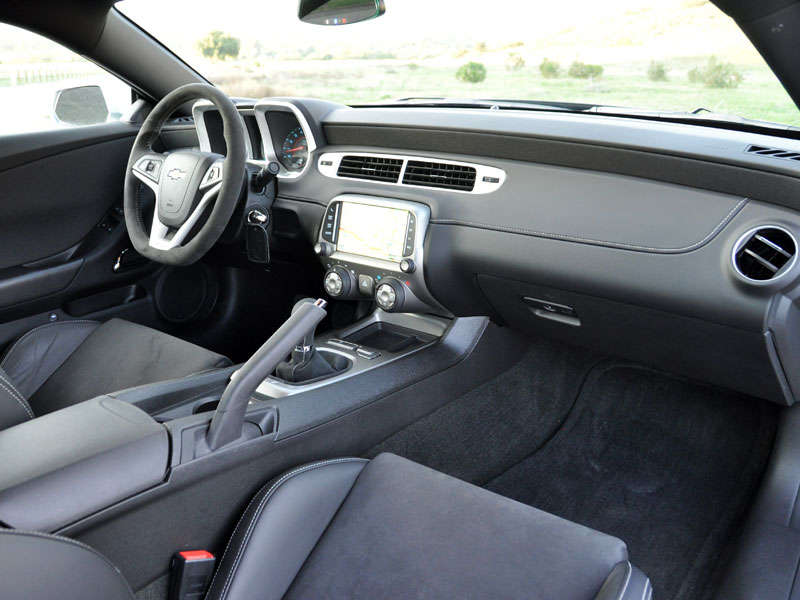
2014 Chevrolet Camaro SS Review and Road Test: Safety and Ratings
- No changes for 2014
Beyond the basics, there’s not much in the way of safety equipment for a 2014 Camaro aside from a reversing camera and rear parking assist sensors, which I strongly recommend. A stability and traction control system is standard, of course, and any Camaro with a V-8 engine includes a Competitive/Sport stability control setting as well as Launch Control technology that helps maximize off-the-line acceleration.
While a Camaro SS 1LE provides astounding grip, I would nevertheless encourage any owner to keep the stability control system fully engaged on public roads, saving the more relaxed settings for track-day or sanctioned drifting events.
In the event that you choose to ignore my advice, know that the Camaro is a safe car based on crash-test ratings from the National Highway Traffic Safety Administration (NHTSA). It gets a 5-star rating in each individual assessment, including for rollover resistance, a rare achievement no matter the type of vehicle.
As this review is written, the Insurance Institute for Highway Safety (IIHS) has not performed crash tests on the Camaro.
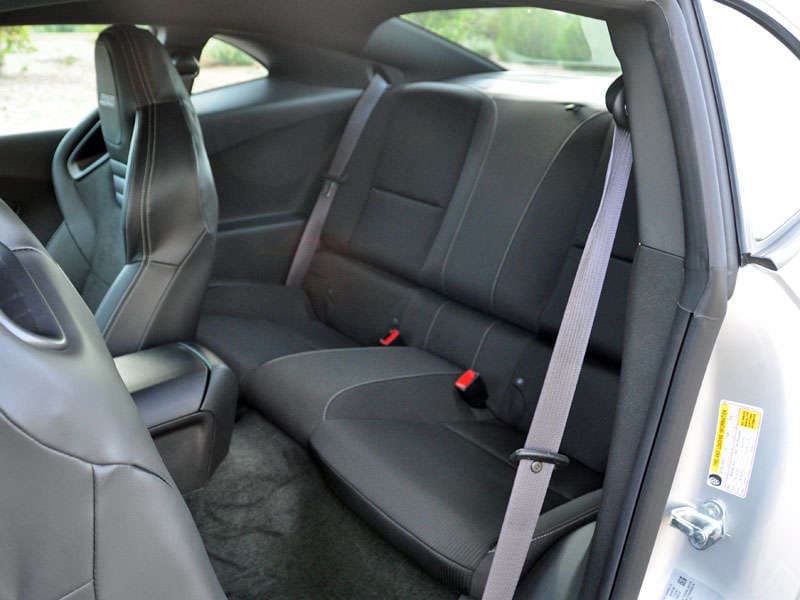
2014 Chevrolet Camaro SS Review and Road Test: Engines and Fuel Economy
- New Camaro Z/28 Coupe with 7.0-liter V-8 engine
Chevrolet offers multiple powertrain combinations for the 2014 Camaro, each of which is appealing in its own right. The LS and LT models get a 323-horsepower 3.6-liter V-6 engine, while the SS is equipped with a 6.2-liter V-8 engine making 400 horsepower when paired with an automatic transmission and 426 horsepower when bolted to a 6-speed manual gearbox. Active Fuel Management technology, which is designed to improve fuel economy, is included for the Camaro SS with an automatic transmission.
Upgrade to the Camaro ZL1 for a supercharged 6.2-liter V-8 generating 580 horsepower and 556 lb.-ft. of torque, good enough to get the hefty car to 60 mph in four seconds flat on the way to a top speed of 184 mph, according to Chevrolet. The new Camaro Z/28 model’s normally aspirated 7.0-liter V-8 engine, sourced from the previous-generation Corvette Z06, isn’t as powerful at 505 horsepower and 481 lb.-ft. of torque, but this car’s hardware package delivers a better Nurburgring lap time than the ZL1, beating the more powerful Camaro by four seconds at the hands of Chevy’s engineers.
My SS 1LE test car had the 426-horse, 6.2-liter V-8 and a close-ratio 6-speed manual transmission with a short-throw shifter. The engine sounded terrific, even without the optional dual-mode exhaust system, and the car proved ferociously fast.
As you might guess, though, fuel economy is terrible. I averaged 16.4 mpg in combined driving, well short of the 19-mpg EPA estimate. But, to be fair to the car, I experienced the transmission’s irritating skip-shift feature just once during an afternoon drive, so I clearly wasn’t trying very hard to conserve gas.
Then again, what person concerned about fuel economy buys a Camaro SS in the first place?
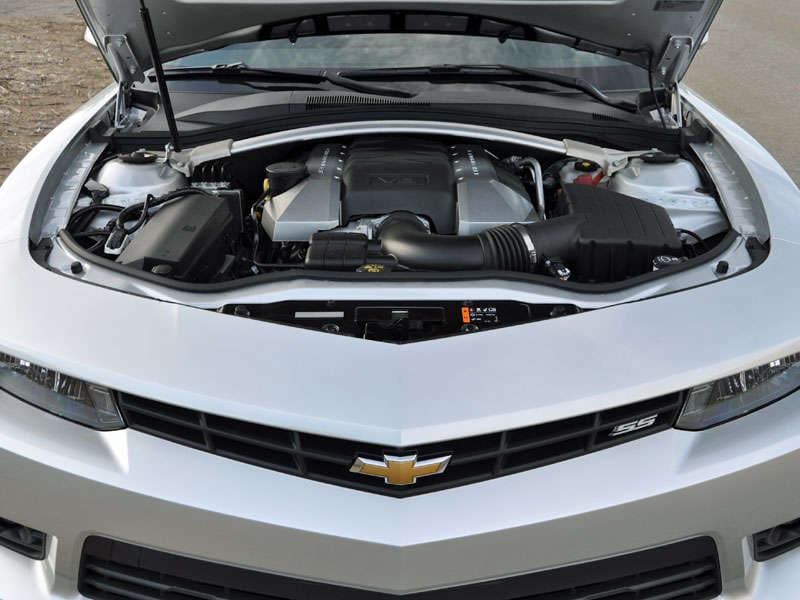
2014 Chevrolet Camaro SS Review and Road Test: Driving Impressions
To explore the performance potential and limits of a 2014 Chevrolet Camaro SS 1LE, a closed racetrack is absolutely necessary. I don’t have one of those. So instead, I drove this Camaro down a couple of my favorite roads and, in the process, barely scratched the surface of what this machine certainly feels capable of achieving.
Starting off, I rocketed the SS 1LE down a freeway ramp and onto a stretch of Ventura County’s Ronald Reagan Freeway that was evidently repaved by drunken idiots. The stiff suspension produced a lousy ride on this mess of cement, but the car’s structure proved rock solid and the Camaro remained firmly affixed to the crappy concrete.
After that test, I dove off the freeway and right into a busy Friday lunch rush in suburbia. Following red light after red light, it was clear that the SS 1LE’s heavy, spring-loaded clutch would rapidly become tiresome if driving this car in traffic on a regular basis, though I suppose that it, combined with the car’s notchy, short-throw shifter, could replace at least half of a daily gym routine. Not that I’m suggesting that an automatic might be preferable.
After duking it out with mommy-mobiles for 30 minutes, a pulse-quickening experience in and of itself due to the Camaro’s narrow windows, thick roof pillars, and tiny side mirrors, I powered into the Santa Monica Mountains and hooked a right onto Mulholland Highway. I drive this stretch of road at least twice a week, and have for more than a decade. It provides a challenging test for everyday vehicles, but this Camaro SS 1LE simply shrugged in indifference. Aside from the aforementioned visibility issue and the car’s palpable width, it took Mulholland like a slot car, demonstrating remarkable grip and amazing grace for what is fundamentally a traditional American muscle car.
Upon reaching the beach, I turned left onto Pacific Coast Highway, the Camaro’s monstrous 6.2-liter V-8 achieving 60 mph within moments. Setting the cruise control to 58 mph on this heavily patrolled stretch of California coastline, the Camaro loafed along, clearly transmitting every change of pavement texture to my ears, backside, and fingertips. Average fuel economy began rising, from the 13s into the 15s, in advance of another left turn back into the mountains.
Piuma Road is magnificent for both its gorgeous, jaw-dropping views and it’s fantastic twists and turns. The pavement here is relatively new and smooth, the double-yellow center line is wider to give the less talented driver a little extra margin of error, there are fewer fallen rocks with which to contend, and it’s easier to see around many of the corners. Here, the Camaro strutted more of its stuff, better demonstrating how its quick and accurate steering doesn’t require the driver to shuffle the wheel, how well its prodigiously-sized braking components resist fade, and how quickly the traction control steps in to limit wheel spin when powering out of tight uphill hairpin corners.
Of course, you can turn that off and burn all of the donuts you like. Just remember what it’s going to cost to replace the 285/35R20 Goodyear Eagle F1 Supercar performance tires wrapped around each rear wheel, or to pay the fines and fees associated with a reckless driving ticket and even more inflated insurance premiums.
Piuma Road also revealed reasons for complaint. My elbow kept whacking the hard plastic on the center console when unwinding the wheel following a tight right hairpin. Both legs hurt while bracing against hard plastic panels. And the thick windshield pillars hide too much stuff on really twisty roads.
Yeah, I know. I’m no fun. But the 2014 Camaro SS 1LE is plenty of it.
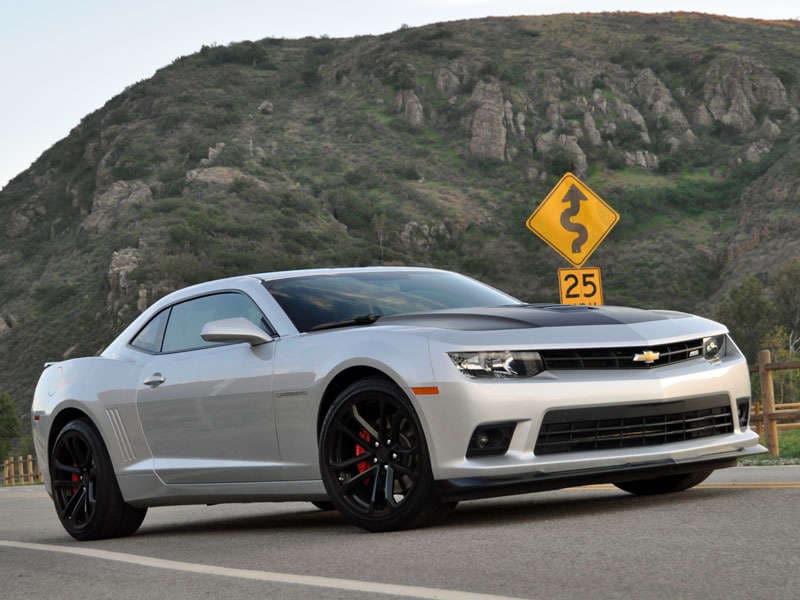
2014 Chevrolet Camaro SS Review and Road Test: Final Thoughts
If you’ve never driven one, it is easy to dismiss a Chevrolet Camaro as a car designed only for going fast in a straight line and leaving smoldering stripes of black rubber on the pavement. While a Camaro with a V-8 engine can certainly live up to that stereotype, when properly equipped it can also rip around a racetrack with unexpected athleticism. It is a flawed machine, yes, and is too big and too heavy in its current form, but I’d rather live in a world containing this Camaro than one without it.
Just don’t draw too many conclusions from the one you rented as a splurge during a vacation. That Camaro, and the one reviewed here, are completely different from a performance perspective.
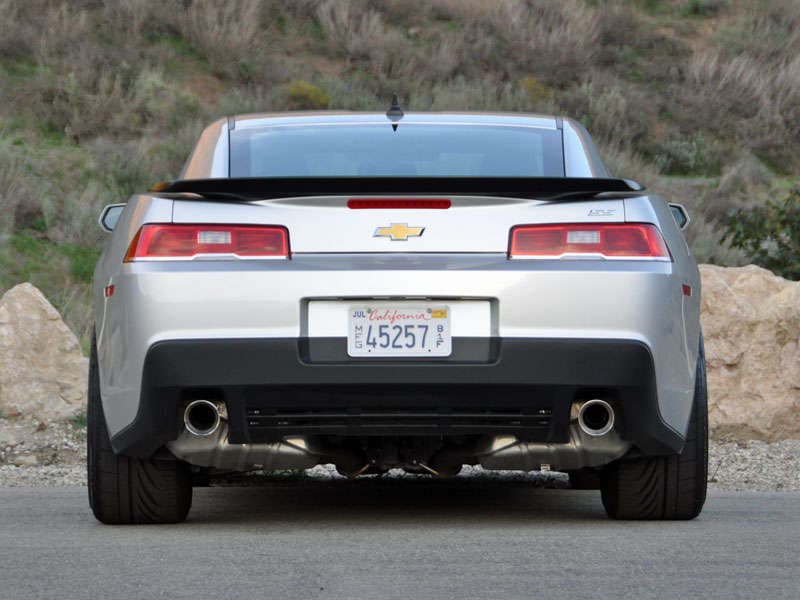
2014 Chevrolet Camaro SS Review and Road Test: Pros and Cons
- Power, performance, and panache
- Impressive handling with 1LE Package
- Terrific look with 1LE Package
- Comfortable, supportive Recaro seat option
- 5-star crash-test ratings
- Hard to get in and out
- Hard to see out, especially when reversing
- Hard plastic where driver braces legs
- Thin steering wheel padding
- Cramped rear seat and trunk
Chevrolet supplied the 2014 Camaro for this review
2014 Chevrolet Camaro SS 1LE photos by Christian Wardlaw
